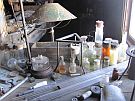Saving old huts in Antarctica
Five parties built bases in the Ross Sea area of Antarctica:
- The 1899 British Antarctic Expedition at Cape Adare.
- Scott’s Discovery Expedition (1901–1904) at Hut Point, Ross Island.
- Shackleton’s Nimrod Expedition (1907–1909) at Cape Royds.
- Scott’s Terra Nova Expedition (1910–1913) at Cape Evans.
- The Trans-Antarctic Expedition (1955–1958) at Pram Point where Hillary built his hut which became New Zealand’s Scott Base.
These expeditions were as much about science as they were about adventure. Huts were built to house people, food, fuel, animals and science equipment.
Scott’s and Shackleton’s wooden huts have lasted for over 100 years in wild Antarctica weather, but they are still being damaged by:
What’s the problem?
The Antarctic Heritage Trust looks after the huts in the Ross Sea area. Work has been done to find out how mould and fungi are damaging the huts and how they can grow in the freezing Antarctic winters.
When temperatures rise above freezing, ice melt in the huts and fungi grows and spreads.
Experts were worried that if too many people visit the huts, heat from their bodies and moisture from their breath could add to this problem. So scientists recorded temperature and humidity in the huts before, during and after groups of visitors. They found that the visits had no effect on the hut environment.
So far, the team have found that the old Antarctic huts have fungi that is well adapted to live in the freezing cold of Antarctica. This fungi causes timbers in the hut to rot. Other items, such as boots and clothing, left by the early explorers has also rotted.
The Antarctic Heritage Trust has been working on restoring the huts and the items found inside these huts.

 wind
wind








